Wholefood Heaven in a Bowl
David and Charlotte Bailey, Pavilion Books Company LtdISBN 978-1-91121-617-9, Pages 159
Raw recipes 11, Cooked recipes 58
“Wholefood Heaven in a Bowl – Natural, Nutritious and Delicious ...,” a Middle Eastern vegetarian cookbook with a strong focus on wholefoods.
Pavilion Books Company Ltd, David and Charlotte Bailey
Raw recipes 11, Cooked recipes 58 (4)
Additional photos (7)
Summary
Wholefood Heaven in a Bowl – Natural, Nutritious and Delicious Wholefood Recipes to Nourish Body and Soul by David and Charlotte Bailey is a vegetarian cookbook that includes many vegan recipes. It is a good cookbook both for those who have experience with a vegan and/or vegetarian diet and those who are just starting out and are ready to try healthier options. The recipes are international and have a special focus on Asian cuisine; they range from easy to prepare to more challenging dishes.
| Critical book reviews It is not common practice for us to use a vegetarian cookbook as a source, but about 70 % of the recipes in this cookbook are vegan. These are the only type we have on our website. |
Overall impression
In their cookbook Wholefood Heaven in a Bowl – Natural, Nutritious and Delicious Wholefood Recipes to Nourish Body and Soul, David and Charlotte Bailey have selected recipes with naturally healthy ingredients. The recipes include vegetables, fruits, nuts, seeds, and grains that have been processed and refined as little as possible. David and Charlotte Bailey use a lot of whole grains and ancient grains and avoid highly processed foods and food additives. They also try to keep the amount of added salt, sugar, and oil to a minimum. It is therefore somewhat surprising that canned foods such as legumes or tomatoes are sometimes called for in the recipes. However, this does not occur very often.
It is helpful that above each recipe the authors have listed whether it is a vegan recipe, includes vegan options, if it includes grains, and if it is gluten-free. Tofu products are found in some recipes but are the exception. You will notice right away that the recipes contain a large number of spices. The dishes are international, and many are clearly influenced by Asian cuisine. The ingredients themselves are readily available. Alongside simple and quick dishes, you will also find quite complicated recipes that require planning and time to prepare. However, it would be nice if the recipes, especially the more involved ones, included the preparation time needed. Since most people will not be familiar with recipes like these, it would be nice if there were photos for all of the recipes and not just for most of them.
Wholefood Heaven in a Bowl is a book that has a strong emphasis on health and features many extraordinary, one-of-a-kind recipes. It is a cookbook that offers even experienced vegan cooks numerous new ideas for recipes.
David and Charlotte Bailey have written two books: Wholefood Heaven in a Bowl and The Fresh Vegan Kitchen, both of which are available from Pavilion books and Amazon.
About the authors
David Bailey, who has several years of experience working in top restaurants, and his wife Charlotte started their business Wholefood Heaven in 2010. They sell vegetarian street food at markets, festivals, and other events. Their famous Buddha Bowl won the 2011 British Street Food Awards for Best Main Dish. In addition to their business, they are continually developing new recipes and writing cookbooks.
Contents
Wholefood Heaven in a Bowl – Natural, Nutritious and Delicious Wholefood Recipes to Nourish Body and Soul begins with an introduction that explains the terms “wholefoods” and “bowls.” The chapter “Wholefood Store Cupboard” provides information about a wide range of ingredients that come under the categories of whole grains, flours, legumes (pulses), nuts and seeds, herbs and spices, tofu and soya chunks, and other things.
The recipes are divided into seven sections:
- Breakfasts and brunch
- Salads
- Soups and stews
- Mains
- Accompaniments and sides
- Baking and desserts
- Drinks
Breakfast and brunch:
This chapter is full of sweet and savory international breakfast and brunch options — from muesli to pancakes and the like. Only one recipe is vegan, but two have vegan options. Most of the other vegetarian dishes contain egg and about half of them dairy products. Examples of recipes in this section are Chia Seed Bircher Bowl and Millet Porridge with Prune Compote and Flaked Almonds.
Salads:
Most of the salads call for cooked ingredients such as grilled vegetables or grains and therefore are not raw food dishes. Four of the eight recipes are vegan, and two more include vegan options. Seaweed, Wild Rice, Tofu, Sesame and Spring Onion Salad and Wholegrain Glass Noodle Salad with Smoked Tofu and Mixed Sprouts are just two examples of the recipes in this section.
Soups and stews:
All of the recipes in this section are vegan or include vegan options. You might try, for example, Sweet Potato and Coconut Soup with Toasted Pumpkin Seeds or the Vietnamese-inspired Pho with Pak Choi, Edamame and Brown Rice Noodles. Apart from canned coconut milk, canned ingredients (here: beans) are only called for on one occasion.
Mains:
About two-thirds of the recipes in this largest section of the cookbook are either vegan or include vegan options. About one-third calls for soy products (e.g., tofu or soya chunks) or canned ingredients. Many of the recipes require several ingredients, which means that they take more time and effort to prepare. Some examples of recipes in this section are the famous Buddha Bowl, Ethiopian Kik Alicha (split stew) with Atakilt Wat (spiced cabbage), Cucumber Salad and Injera Flatbread, and Mexican Bean Pot Bowl with Citrus Chard.
Accompaniments and sides:
Apart from one exception, all of the dishes in this section are vegan. You will find fermented vegetables such as Basic Kimchi, spice pastes and savory sauces like Seeni Sambol, and vegetable sides and toppings such as Hazelnut Dukkah.
Baking and desserts:
The majority of the recipes here contain either eggs or dairy products and therefore are not vegan. An example of one of the three vegan recipes is Vegan Carrot Halwa.
Drinks:
Alongside Milky Masala Chai and Tiger’s Milk, this section includes numerous smoothies and refreshing drinks such as the Switchel with lemon and ginger.
Book review written by Dr. med. vet. Inke Weissenborn
This colorful salad with seaweed (dulse), wild rice, tofu, sesame, and spring onions (scallions) is refreshing and healthy. It is rich in iodine.
Thanks to the ginger, this soothing sweet potato and coconut soup with toasted pumpkin seeds is very warming – and added cinnamon gives it a delicious flavor.
This version of pho with pak choi, edamame, and brown rice noodles is amazingly delicious, with the added bonus that it doesn’t contain any meat or fish sauce.
The healthy sweet potato and coconut soup with pumpkin seeds warms you up with the ginger and rounds off the taste with a delicate cinnamon aroma.

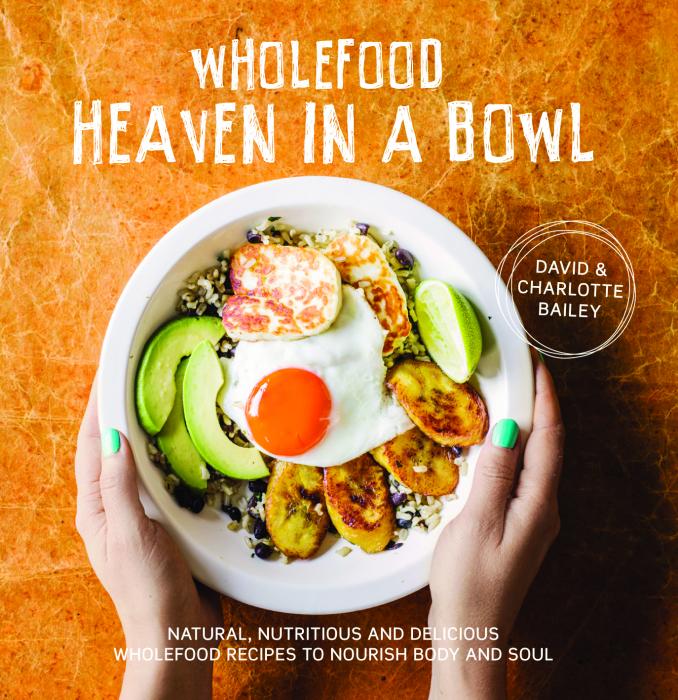
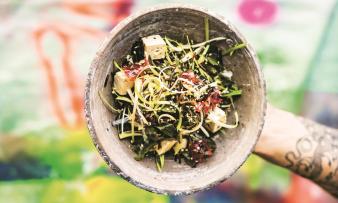
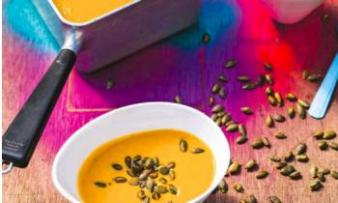
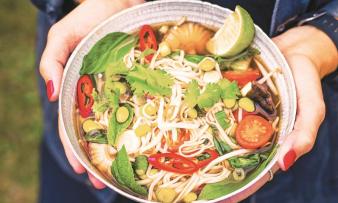
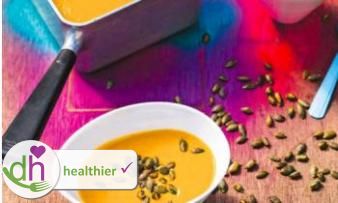
Comments